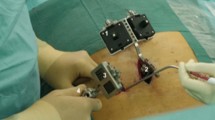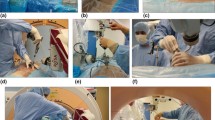Abstract
To evaluate the feasibility and accuracy of AR-assisted pedicle screw placement using a new intraoperative rapid registration method of combining preoperative CT scanning and intraoperative C-arm 2D fluoroscopy in cadavers. Five cadavers with intact thoracolumbar spines were employed in this study. Intraoperative registration was performed using anteroposterior and lateral views of preoperative CT scanning and intraoperative 2D fluoroscopic images. Patient-specific targeting guides were used for pedicle screw placement from Th1-L5, totaling 166 screws. Instrumentation for each side was randomized (augmented reality surgical navigation (ARSN) vs. C-arm) with an equal distribution of 83 screws in each group. CT was performed to evaluate the accuracy of both techniques by assessing the screw positions and the deviations between the inserted screws and planned trajectories. Postoperative CT showed that 98.80% (82/83) screws in ARSN group and 72.29% (60/83) screws in C-arm group were within the 2-mm safe zone (p < 0.001). The mean time for instrumentation per level in ARSN group was significantly shorter than that in C-arm group (56.17 ± 3.33 s vs. 99.22 ± 9.03 s, p < 0.001). The overall intraoperative registration time was 17.2 ± 3.5 s per segment. AR-based navigation technology can provide surgeons with accurate guidance of pedicle screw insertion and save the operation time by using the intraoperative rapid registration method of combining preoperative CT scanning and intraoperative C-arm 2D fluoroscopy.







Similar content being viewed by others
Data Availability
The datasets generated and/or analysed during the current study are available from the corresponding author on reasonable request.
References
Kosmopoulos V, Schizas C. Pedicle screw placement accuracy: a meta-analysis. Spine (Phila Pa 1976). 2007. 32(3): E111–20.
Dennler C, Jaberg L, Spirig J, et al. Augmented reality-based navigation increases precision of pedicle screw insertion. J Orthop Surg Res. 2020. 15(1): 174.
Yao Y, Jiang X, Wei T, et al. A real-time 3D electromagnetic navigation system for percutaneous pedicle screw fixation in traumatic thoraco-lumbar fractures: implications for efficiency, fluoroscopic time, and accuracy compared with those of conventional fluoroscopic guidance. Eur Spine J. 2022. 31(1): 46-55.
Sun J, Wu D, Wang Q, Wei Y, Yuan F. Pedicle Screw Insertion: Is O-Arm-Based Navigation Superior to the Conventional Freehand Technique? A Systematic Review and Meta-Analysis. World Neurosurg. 2020. 144: e87-e99.
Elmi-Terander A, Skulason H, Söderman M, et al. Surgical Navigation Technology Based on Augmented Reality and Integrated 3D Intraoperative Imaging: A Spine Cadaveric Feasibility and Accuracy Study. Spine (Phila Pa 1976). 2016. 41(21): E1303-E1311.
Elmi-Terander A, Burström G, Nachabe R, et al. Pedicle Screw Placement Using Augmented Reality Surgical Navigation With Intraoperative 3D Imaging: A First In-Human Prospective Cohort Study. Spine (Phila Pa 1976). 2019. 44(7): 517–525.
Jin M, Liu Z, Liu X, et al. Does intraoperative navigation improve the accuracy of pedicle screw placement in the apical region of dystrophic scoliosis secondary to neurofibromatosis type I: comparison between O-arm navigation and free-hand technique. Eur Spine J. 2016. 25(6): 1729-37.
Liu YJ, Tian W, Liu B, et al. Comparison of the clinical accuracy of cervical (C2-C7) pedicle screw insertion assisted by fluoroscopy, computed tomography-based navigation, and intraoperative three-dimensional C-arm navigation. Chin Med J (Engl). 2010. 123(21): 2995-8.
Su AW, McIntosh AL, Schueler BA, et al. How Does Patient Radiation Exposure Compare With Low-dose O-arm Versus Fluoroscopy for Pedicle Screw Placement in Idiopathic Scoliosis. J Pediatr Orthop. 2017. 37(3): 171-177.
Balling H. Time Demand and Radiation Dose in 3D-Fluoroscopy-based Navigation-assisted 3D-Fluoroscopy-controlled Pedicle Screw Instrumentations. Spine (Phila Pa 1976). 2018. 43(9): E512-E519.
Burström G, Persson O, Edström E, Elmi-Terander A. Augmented reality navigation in spine surgery: a systematic review. Acta Neurochir (Wien). 2021. 163(3): 843-852.
Müller F, Roner S, Liebmann F, Spirig JM, Fürnstahl P, Farshad M. Augmented reality navigation for spinal pedicle screw instrumentation using intraoperative 3D imaging. Spine J. 2020. 20(4): 621-628.
Gibby JT, Swenson SA, Cvetko S, Rao R, Javan R. Head-mounted display augmented reality to guide pedicle screw placement utilizing computed tomography. Int J Comput Assist Radiol Surg. 2019. 14(3): 525-535.
Vaccaro AR, Harris JA, Hussain MM, et al. Assessment of Surgical Procedural Time, Pedicle Screw Accuracy, and Clinician Radiation Exposure of a Novel Robotic Navigation System Compared With Conventional Open and Percutaneous Freehand Techniques: A Cadaveric Investigation. Global Spine J. 2020. 10(7): 814-825.
Ammirati M, Salma A. Placement of thoracolumbar pedicle screws using O-arm-based navigation: technical note on controlling the operational accuracy of the navigation system. Neurosurg Rev. 2013. 36(1): 157–62; discussion 162.
Ma L, Zhao Z, Chen F, Zhang B, Fu L, Liao H. Augmented reality surgical navigation with ultrasound-assisted registration for pedicle screw placement: a pilot study. Int J Comput Assist Radiol Surg. 2017. 12(12): 2205-2215.
Edgcumbe P, Pratt P, Yang GZ, Nguan C, Rohling R. Pico Lantern: Surface reconstruction and augmented reality in laparoscopic surgery using a pick-up laser projector. Med Image Anal. 2015. 25(1): 95-102.
Peh S, Chatterjea A, Pfarr J, et al. Accuracy of augmented reality surgical navigation for minimally invasive pedicle screw insertion in the thoracic and lumbar spine with a new tracking device. Spine J. 2020. 20(4): 629-637.
Zhang W, Takigawa T, Wu Y, Sugimoto Y, Tanaka M, Ozaki T. Accuracy of pedicle screw insertion in posterior scoliosis surgery: a comparison between intraoperative navigation and preoperative navigation techniques. Eur Spine J. 2017. 26(6): 1756-1764.
Lieberman IH, Togawa D, Kayanja MM, et al. Bone-mounted miniature robotic guidance for pedicle screw and translaminar facet screw placement: Part I--Technical development and a test case result. Neurosurgery. 2006. 59(3): 641–50; discussion 641–50.
Togawa D, Kayanja MM, Reinhardt MK, et al. Bone-mounted miniature robotic guidance for pedicle screw and translaminar facet screw placement: part 2--Evaluation of system accuracy. Neurosurgery. 2007. 60(2 Suppl 1): ONS129–39; discussion ONS139.
Lai DM, Shih YT, Chen YH, Chien A, Wang JL. Effect of pedicle screw diameter on screw fixation efficacy in human osteoporotic thoracic vertebrae. J Biomech. 2018. 70: 196-203.
Jeswani S, Drazin D, Hsieh JC, et al. Instrumenting the small thoracic pedicle: the role of intraoperative computed tomography image-guided surgery. Neurosurg Focus. 2014. 36(3): E6.
Saraf SK, Singh RP, Singh V, Varma A. Pullout strength of misplaced pedicle screws in the thoracic and lumbar vertebrae - A cadaveric study. Indian J Orthop. 2013. 47(3): 238-43.
Pérez-Pachón L, Sharma P, Brech H, et al. Effect of marker position and size on the registration accuracy of HoloLens in a non-clinical setting with implications for high-precision surgical tasks. Int J Comput Assist Radiol Surg. 2021. 16(6): 955-966.
Chien JC, Tsai YR, Wu CT, Lee JD. HoloLens-Based AR System with a Robust Point Set Registration Algorithm. Sensors (Basel). 2019. 19(16).
Grubert J, Itoh Y, Moser K, Swan JE. A Survey of Calibration Methods for Optical See-Through Head-Mounted Displays. IEEE Trans Vis Comput Graph. 2018. 24(9): 2649-2662.
Sun Q, Mai Y, Yang R, Ji T, Jiang X, Chen X. Fast and accurate online calibration of optical see-through head-mounted display for AR-based surgical navigation using Microsoft HoloLens. Int J Comput Assist Radiol Surg. 2020. 15(11): 1907-1919.
Hu X, Baena F, Cutolo F. Head-Mounted Augmented Reality Platform for Markerless Orthopaedic Navigation. IEEE J Biomed Health Inform. 2022. 26(2): 910-921.
Xu B, Yang Z, Jiang S, Zhou Z, Jiang B, Yin S. Design and Validation of a Spinal Surgical Navigation System Based on Spatial Augmented Reality. Spine (Phila Pa 1976). 2020. 45(23): E1627-E1633.
Verma SK, Singh PK, Agrawal D, et al. O-arm with navigation versus C-arm: a review of screw placement over 3 years at a major trauma center. Br J Neurosurg. 2016. 30(6): 658-661.
Liu H, Chen W, Liu T, Meng B, Yang H. Accuracy of pedicle screw placement based on preoperative computed tomography versus intraoperative data set acquisition for spinal navigation system. J Orthop Surg (Hong Kong). 2017. 25(2): 2309499017718901.
Van de Kelft E, Costa F, Van der Planken D, Schils F. A prospective multicenter registry on the accuracy of pedicle screw placement in the thoracic, lumbar, and sacral levels with the use of the O-arm imaging system and StealthStation Navigation. Spine (Phila Pa 1976). 2012. 37(25): E1580–7.
Chen L, Zhang F, Zhan W, Gan M, Sun L. Optimization of virtual and real registration technology based on augmented reality in a surgical navigation system. Biomed Eng Online. 2020. 19(1): 1.
Jud L, Fotouhi J, Andronic O, et al. Applicability of augmented reality in orthopedic surgery - A systematic review. BMC Musculoskelet Disord. 2020. 21(1): 103.
Wu JR, Wang ML, Liu KC, Hu MH, Lee PY. Real-time advanced spinal surgery via visible patient model and augmented reality system. Comput Methods Programs Biomed. 2014. 113(3): 869-81.
Hussain I, Cosar M, Kirnaz S, et al. Evolving Navigation, Robotics, and Augmented Reality in Minimally Invasive Spine Surgery. Global Spine J. 2020. 10(2 Suppl): 22S-33S.
Burström G, Nachabe R, Persson O, Edström E, Elmi Terander A. Augmented and Virtual Reality Instrument Tracking for Minimally Invasive Spine Surgery: A Feasibility and Accuracy Study. Spine (Phila Pa 1976). 2019. 44(15): 1097–1104.
Auloge P, Cazzato RL, Ramamurthy N, et al. Augmented reality and artificial intelligence-based navigation during percutaneous vertebroplasty: a pilot randomised clinical trial. Eur Spine J. 2020. 29(7): 1580-1589.
Molina CA, Dibble CF, Lo SL, Witham T, Sciubba DM. Augmented reality-mediated stereotactic navigation for execution of en bloc lumbar spondylectomy osteotomies. J Neurosurg Spine. 2021 : 1–6.
Spirig JM, Roner S, Liebmann F, Fürnstahl P, Farshad M. Augmented reality-navigated pedicle screw placement: a cadaveric pilot study. Eur Spine J. 2021. 30(12): 3731-3737.
Molina CA, Sciubba DM, Greenberg JK, Khan M, Witham T. Clinical Accuracy, Technical Precision, and Workflow of the First in Human Use of an Augmented-Reality Head-Mounted Display Stereotactic Navigation System for Spine Surgery. Oper Neurosurg (Hagerstown). 2021. 20(3): 300-309.
Author information
Authors and Affiliations
Contributions
CXS (MD, Orthopedic Surgeon) designed the study, carried out most of the data analysis, and was a major contributor in writing the manuscript; CB (MM, Orthopedic Surgeon), YB (MD, Orthopedic Surgeon), and XGF (MM, Orthopedic Surgeon) performed the examination of the data, and substantively revised the manuscript, should be considered as co-first authors. ZY (MD, Orthopedic Surgeon), SYQ (MD, Orthopedic Surgeon), ZSY (MD, Orthopedic Surgeon), XZ (Mm, Orthopedic Surgeon), and WY (MD, Orthopedic Surgeon) proposed the idea of study design and finished the final assessment of the manuscript. The authors read and approved the final manuscript.
Corresponding author
Ethics declarations
Ethical Approval
All procedures involving human participants abided by the 1964 Declaration of Helsinki and its amendments. For this is a retrospective study, ethical approval is not required.
Consent to Participate
Not required.
Consent for Publication
Not required.
Device Status/Drug Statement
The manuscript submitted does not contain information about medical device(s)/drug(s).
Conflict of Interest
The authors declare no competing interests.
Additional information
Publisher's Note
Springer Nature remains neutral with regard to jurisdictional claims in published maps and institutional affiliations.
Rights and permissions
Springer Nature or its licensor (e.g. a society or other partner) holds exclusive rights to this article under a publishing agreement with the author(s) or other rightsholder(s); author self-archiving of the accepted manuscript version of this article is solely governed by the terms of such publishing agreement and applicable law.
About this article
Cite this article
Cao, B., Yuan, B., Xu, G. et al. A Pilot Human Cadaveric Study on Accuracy of the Augmented Reality Surgical Navigation System for Thoracolumbar Pedicle Screw Insertion Using a New Intraoperative Rapid Registration Method. J Digit Imaging 36, 1919–1929 (2023). https://doi.org/10.1007/s10278-023-00840-x
Received:
Revised:
Accepted:
Published:
Issue Date:
DOI: https://doi.org/10.1007/s10278-023-00840-x




